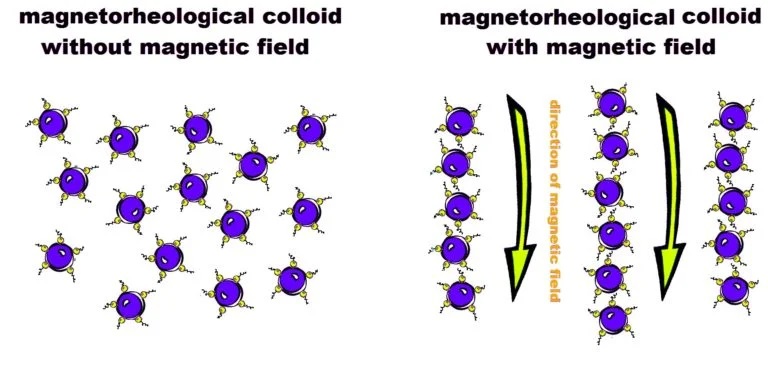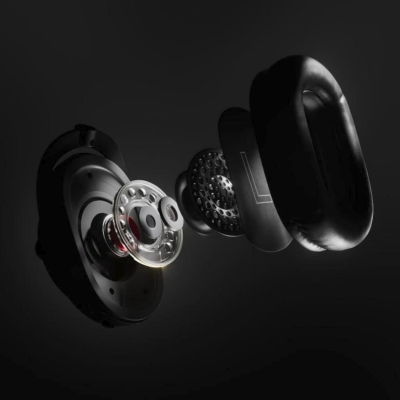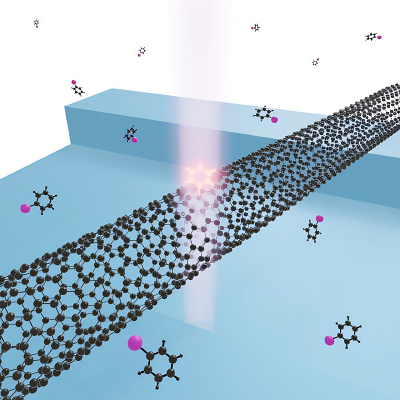Magnetorheological Fluids (MRF) are liquids also called colloidal suspensions that change their rheological properties in the presence of external magnetic fields. What does it mean in practice? When they are exposed to a magnetic field, they can quickly solidify, while after removing the external magnetic field, they quickly return to their original suspension state becoming liquid. So, their state of matter can be easily changed with magnets or electromagnets thanks to their fantastic structure.
The secret of such behavior lies in their chemical composition. They are based on tiny, nano- or micrometer-sized, magnetic particles suspended in the oil or other viscous liquid. These particles create chain-like structures, which are responsible for property changes. Without the magnetic field, all nanoparticles are randomly dispersed in the liquid, while in the presence of the magnetic field, they form tiny chains that giving the liquid a rigid structure.
These nanoparticles that react to the magnetic field are made from magnetic compounds (ferromagnetic powder like carbonyl iron powder, cobalt, or nickel) and non-magnetic compounds (like water, silicone oil, mineral oil, or other liquids having large viscosity, e.g., glycol). Depending on the size of particular grains in a powder dispersed in a colloidal suspension, the type of materials used as a powder, and liquid viscosity, the suspension’s stiffness in a magnetic field can be different.
Not so long history of MR fluids
Discovered over 80 years ago, Magnetorheological Fluids (MR fluids), despite very advanced and intensive research, initially military, and from the beginning of the 1970s also civilian, remain in the center of interest of many universities and research centers. They were the first to be tested in the army. It was, among others, a Liquid Armor, which consists of Kevlar (heat-resistant and strong synthetic fiber) soaked in an MR Fluid. These are what protect people from the effects of the explosions.
At present, such a coating can also be used as plating for pipelines such as oil and gas, petrochemical, drinking water, sewage, sludge and sludge, and many others.

The colloidal suspension of magnetic particles dispersed in a viscous liquid without and with a magnetic field.
Let’s go back for a moment to the beginnings of the civil application of this clever liquid. In particular, since 2002, when it was used in the damper of Cadillac STS. It was then that their expansion began on a broad front. Presently, they can be found in devices like the damper (or shock absorber), brake, clutch, mount, prosthetic leg, and lower-limb exoskeleton. That is undoubtedly their special properties consisting of quick changes in the liquid’s apparent viscosity, ease of control, and possibly a wide range of applications in technical devices.
These smart fluids are also widely used in buildings and bridges to counteract wind gusts in windy regions or places where earthquakes occur. Thanks to their properties, even very high skyscrapers are resistant to damaging vibrations. How does it work? MR Fluid is placed in special devices like dampers in the car, so depending on the size and height of the building, even hundreds of them can be installed inside for effective vibration dissipation. Such a ladder-like damping matrix can save a skyscraper during even the strongest earthquakes.
Other application fields are connected with mirrors. Not the classical one, but the liquid ones. They offer very smooth surfaces considering the low cost. How is it possible? The rotating fluid takes the shape of a paraboloid. In this way, the paraboloid mirror is formulated. One way to obtain the surface of such mirrors is to rely on them using a Magnetorheological Fluid. It is used as a polishing pad to conform well to the surface. This procedure is called Magnetorheological finishing. It has been applied, for example, to the Hubble Space Telescope’s corrective lens.
Recently, the smart MRF has been applied even in rehabilitation equipment to stabilize injured joints like ankles, elbows, knees, or other joints. Other medical applications are connected with cancer, which is considered the second leading cause of death globally, treatment. In a specific treatment application like surgery, chemotherapy, radiotherapy, the survival rate is still poor, while the Magnetorheological Fluids having specific chemical composition give us tremendous hope.
When the magnetic nanoparticles are coated with some compounds and dispersed in water, forming colloidal suspension, they can be used, for example, to block the blood supply to a tumor to starve it. Therapy involves injecting magnetic suspension into a blood vessel and placing a magnet on the tumor. Without a blood supply, tumor necrosis occurs. Of course, such MR fluid for biological use has a different chemical composition than the MR Fluid for dampers or rehabilitation. This experimental method of fighting tumors, like many others, is still under research. Let’s hope it turns out to be effective.
Did you know that?
− Seat suspension in heavy trucks uses semi-active vibration control based on MR Fluids. They were introduced back in 1998, and they are trendy on American highways because of their efficiency on longer routes. Currently, there is over 5000 MR Fluids-based systems.
− MR Fluid-filled pads can be used instead of foam pads as protection from gun recoil. They significantly reduce the harm done by recoil, are more durable, and can be used in extreme temperatures. The algorithm controls the timing and magnetic field so that MR Fluid can be converted to solid as soon as recoil.
− MR Fluid serves as a polishing agent in devices polishing optical surfaces. Using a computer program controlling an electromagnet, we can predict the final smoothness and form of the polished objects.
− MR Fluid can be used in soft robotics – a field of robotics that mimics the movement of living organisms. Using a magnetic field solely makes it possible to remote control a soft robot, which reduces the number of elements and miniaturization. It’s controlled by both strength and direction of the magnetic field.
− The approximate cost of MR Fluid is from 500$ up to 1000$ per liter. About 90% of its cost is magnetic material (for example, carbonyl iron).
− You may find MRF at home. The most vibrating machine at home is usually the washing machine. To dampen drums, some washing machines are equipped with dampers filled with MR Fluids.
Read the original article on Technology Org.







